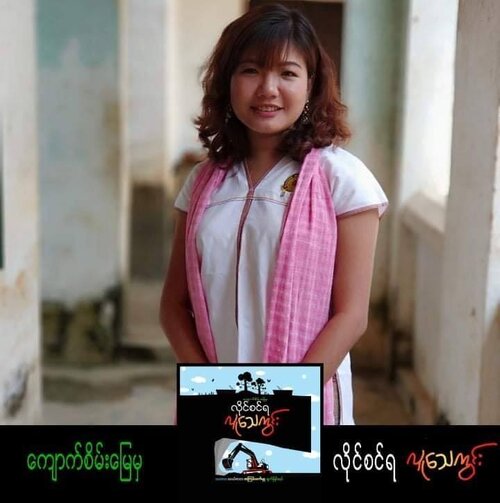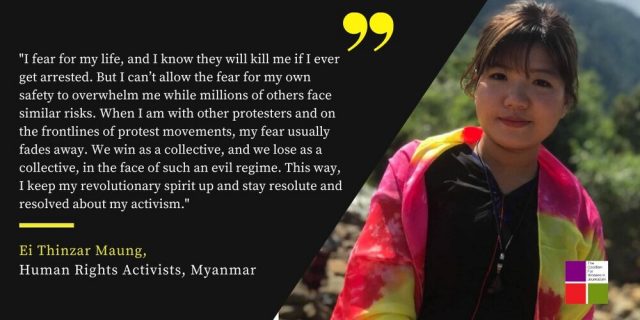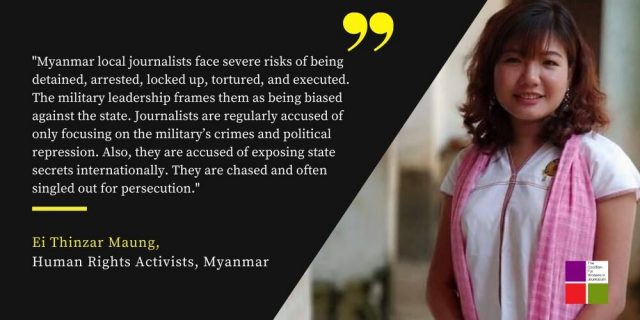Interview with Ei Thinzar Maung

By the Coalition For Women In Journalism
“They will kill me if I ever get arrested”, Ei Thinzar Maung, an iconic Myanmar activist, discusses blatant cruelty and the mercilessness of military rule
Journalists, activists, and civilians are severely beaten, chased, shot, sexually harassed, and executed in broad daylight.

In the unfolding Spring Revolution against the military coup of February 1, Ei Thinzar Maung has emerged as a fierce political activist and a symbol of public resistance. Her fiery oratory and intelligent analyses won over the public’s heart and made her a leader for the people to follow. However, such dedication comes with a great price. “I fear for my life. And I know they will kill me if I ever get arrested”, Ei Thinzar Maung revealed in a conversation with CFWIJ’s Katarzyna Mierzejewska. “Everyone is fearful of being arrested, abducted, tormented, or even executed on the street because the security troops are killing wantonly day and night, on the streets or inside residential homes”, she says. Ei Thinzar Maung is currently on the military regime’s wanted list of activists.
The situation in Myanmar is rapidly deteriorating. Due to severe safety concerns, Ei Thinzar Maung, like dozens of other activists and journalists, remains in hiding inside the country. However, she never ceased to participate in the civil resistance movement in Myanmar. Ei Thinzar uses all of the resources at her disposal to support their democratic agenda. Ei Thinzar Maung spoke to The Coalition For Women In Journalism (CFWIJ) about the cruelty ravaging Myanmar and its citizens.
The Coalition For Women In Journalism (CFWIJ) is horrified by the pervasive brutality of the army and blatant violations of basic human rights. We are in regular contact with journalists and activists on the ground who are tormented, abducted, and beaten yet continue to operate in hiding. CFWIJ gives a platform to journalists who fearlessly carry on with their reporting to share their experiences and expose the appalling reality in Myanmar. We stand by the courageous people in Myanmar and will continue to support them in any way we can.
Katarzyna Mierzejewska: We have been speaking to several journalists and activists in Myanmar who emphasize the immense scale of violence tearing the country apart. The army continues its crackdown on civil liberties, but people’s tenacity is extraordinary. Given that the situation is very dynamic, could you shed light on the recent distressing developments?
Ei Thinzar Maung: The military has been on a killing spree, terrorizing protesters and non-protesters in the same merciless way. The regular army units and other security forces are seen shooting protesters in the heads, executing them in broad daylight, shooting children in the playground or in their own homes. Not even visibly pregnant women who show their support for youth protesters have been spared. Going beyond the scope of their mandate, Myanmar security forces demonstrate sadistic behavior, terrorizing unarmed residents and peaceful protesters. These security troops also engage in senseless vandalism, theft, looting, arson and property destruction in all neighborhoods and protest sites in cities, towns and villages.
What do the protests look like now? I spoke to several journalists who bravely continue their coverage, and they all mention that protests are now organized in smaller townships while activists put their lives at risk every single day. How do people feel, how does the brutality and fear affect them?
Given the extreme brutality the security forces use to disperse protesters – all practically unarmed and peaceful – the protests have become smaller than the earlier waves, which attracted millions of people. However, the determination of the protesters, primarily made up of young students and labor activists, has only grown stronger in response to the security forces’ barbaric behavior. There is so much creativity on the part of protest organizers who resort to numerous unusual forms of opposition to the military. The community members who do not join the protests have shown tremendous empathy and solidarity while providing concrete support such as safe houses, food, money, and information about the troops. Besides student protests, the Civil Disobedience Movement, led by civil servants such as doctors, nurses, teachers, academics, engineers, railway employees, and other professionals, continues to cripple the military’s ability to run the central state administration.
Everyone is fearful of being arrested, abducted, tortured, or even executed on the street because the security troops are killing wantonly day and night, on the streets or inside residential homes. So many of us feel we are not safe simply existing as humans in the country under the siege of this terroristic regime. Women and girls are now in constant danger of being raped and gang-raped. For decades, Myanmar security forces have been using rape as a weapon of war and political subjugation, particularly in the ancestral regions of national minorities such as Shan, Kachin, Karen, Rohingyas, and so on. Shan Woman Action Network broke ground internationally in calling the world’s attention to the Myanmar military’s use of rape as an instrument of terror with its License to Rape report released almost 20 years ago. Thus, the military’s practice of rape and threats of rape, with total impunity, has continued throughout the country.

Can you describe the main threats to the press and journalists? Many of them now operate in hiding.
Myanmar local journalists face severe risks of being detained, arrested, locked up, tortured, and executed. The military leadership frames them as being biased against the state. Journalists are regularly accused of only focusing on the military’s crimes and political repression. Also, they are accused of exposing state secrets internationally. They are chased and often singled out for persecution.
Tell us more about your experience with protests as an activist in the spotlight.
I fear for my life, and I know they will kill me if I ever get arrested. But I can’t allow the fear for my own safety to overwhelm me while millions of others face similar risks. When I am with other protesters and on the frontlines of protest movements, my fear usually fades away. It is only when I am alone the fear returns to me. I take comfort in the view that we are all in this together. We win as a collective, and we lose as a collective, in the face of such an evil regime. This way, I keep my revolutionary spirit up and stay resolute and resolved about my activism.
Have you experienced violence? Have people close to you endured physical attacks or any kind of state persecution?
Yes, I was beaten in the crackdown of our student march of 404 miles in 2015, and I was locked up for over a year. A few weeks ago, before I had to go underground because the risks became too great, I lost a very close friend and fellow woman dissident I was in jail with. That was hard emotionally.
You have been protesting against the military coup since the very beginning. How would you say the situation has changed in the last two months? Could you describe it in detail?
The earlier crackdowns involved water cannons, rubber bullets, and other typical riot control methods. Then, the military leadership ordered its security troops to shoot to kill and aim for the heads of protesters. They also broadcast on official propaganda TV stations that parents and family members should keep their loved ones at home unless they want to see their activist family members shot “in the head and the back of the head”. Many troops videotaped themselves and published these clips in which they say they will rape or kill unarmed protestors.
The troops have been using scorched earth or Four Cut military strategies (cutting food, new recruits, information, and other supplies) in many urban neighborhoods. Residents and protesters alike are wrongly but intentionally framed as enemies, manipulated by outside powers such as Western governments and political foundations. These are military strategies the troops use against armed ethnic organizations and their communities in minority regions. Now, the troops employ these methods in cities and towns where the ethnic majority live. The regime has also tried to create news and information black-outs through internet shutdowns and interrupting mobile data services. The regime also brought back repressive Draconian measures from the previous era of military dictatorships, such as requiring every household in villages and towns to report any overnight visitors in their homes. The coup regime has also targeted philanthropists, public opinion-makers, and celebrities to block any type of moral, material, and financial support. But practically every community, village, town, and city is united in their opposition— not just against the coup regime, but its main instrument of terror, called Tatmadaw (or the Defence Forces). The public wants to defeat this repressive regime by any means necessary. Thousands of protesters have gone over to ethnic armed organizations and undergo armed resistance training programs. The public views the military regime as a gang of terrorists and aspire to set up a new Federal Army in its place, working with national minority communities.

The police and army are viciously violent towards protesters. On social media, we are inundated with disturbing images of people either killed or severely injured. Could you describe to us what it looks like in the eye of the storm? I want our readers to understand how risky it is to protest or even silently support the Civil Disobedience Movement in Myanmar.
Every time I join the street protests, I know I may be killed. I have seen fellow protesters shot, hauled away, or savagely beaten by security troops right before my eyes. It makes my blood boil. As I said before, we win or lose together as a movement. So, I feel empowered and unafraid, if only for a short moment, when I am with other protesters.
What do you think will happen next? Activists insist that the revolution must prevail, but is it even possible? Is the army willing to sit down and negotiate? What are the demands of the public resistance?
We will eventually win. We have no other option but to defeat the evil that has been terrorizing our peoples for nearly 60 years since the coup of 1962. Every one of us knows the country’s military is an existential threat to all of us. So, we are at the now or never moment in our country’s political history. These men in uniform, whom we commonly refer to as terrorists, will not negotiate with the protest movement whatsoever. Our revolution demands to abolish the anti-democratic constitution drawn up by the military to ensure its power. We seek the establishment of transparent federal democracy, as well as accountability for the leaders who perpetrated international crimes against unarmed civilian populations— protesters and non-protesters alike.
Ei Thinzar Maung is a respected and well-known human rights activist who has emerged as a symbol of the ongoing protests in Myanmar. Her commitment to defending social liberties long-standing.As a Kachin woman student at Mandalay University, she cut her political teeth in the nationwide student protest movement against the National Education Law proposed by the quasi-democratic government of ex-General and President Thein Sein in 2014. The prospective law promised a ban against student unions, a ban on teaching ethnic minority languages, and the prohibition of academic autonomy for universities and colleges. In the bloody crackdown against the 404 Miles March, organized by students opposing the new law in 2015, Ei Thinzar was arrested and detained for over a year. She was one of Myanmar’s vocal opponents against the Rohingya genocide. She was a promising leader of the second-oldest party, A Democratic Party for a New Society, until March. She is currently on the military regime’s wanted list of activists and remains in hiding in Myanmar.

Original post: the Coalition For Women In Journalism

